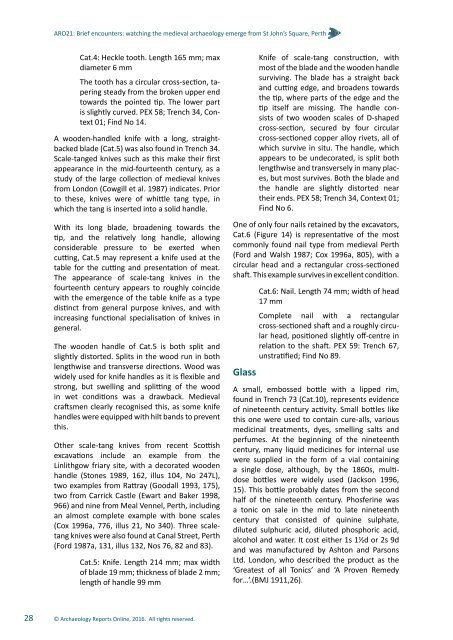medieval archaeology emerge from St John’s Square Perth
ARO21_St_Johns_Square
ARO21_St_Johns_Square
Create successful ePaper yourself
Turn your PDF publications into a flip-book with our unique Google optimized e-Paper software.
ARO21: Brief encounters: watching the <strong>medieval</strong> <strong>archaeology</strong> <strong>emerge</strong> <strong>from</strong> <strong>St</strong> <strong>John’s</strong> <strong>Square</strong>, <strong>Perth</strong><br />
Cat.4: Heckle tooth. Length 165 mm; max<br />
diameter 6 mm<br />
The tooth has a circular cross-section, tapering<br />
steady <strong>from</strong> the broken upper end<br />
towards the pointed tip. The lower part<br />
is slightly curved. PEX 58; Trench 34, Context<br />
01; Find No 14.<br />
A wooden-handled knife with a long, straightbacked<br />
blade (Cat.5) was also found in Trench 34.<br />
Scale-tanged knives such as this make their first<br />
appearance in the mid-fourteenth century, as a<br />
study of the large collection of <strong>medieval</strong> knives<br />
<strong>from</strong> London (Cowgill et al. 1987) indicates. Prior<br />
to these, knives were of whittle tang type, in<br />
which the tang is inserted into a solid handle.<br />
With its long blade, broadening towards the<br />
tip, and the relatively long handle, allowing<br />
considerable pressure to be exerted when<br />
cutting, Cat.5 may represent a knife used at the<br />
table for the cutting and presentation of meat.<br />
The appearance of scale-tang knives in the<br />
fourteenth century appears to roughly coincide<br />
with the <strong>emerge</strong>nce of the table knife as a type<br />
distinct <strong>from</strong> general purpose knives, and with<br />
increasing functional specialisation of knives in<br />
general.<br />
The wooden handle of Cat.5 is both split and<br />
slightly distorted. Splits in the wood run in both<br />
lengthwise and transverse directions. Wood was<br />
widely used for knife handles as it is flexible and<br />
strong, but swelling and splitting of the wood<br />
in wet conditions was a drawback. Medieval<br />
craftsmen clearly recognised this, as some knife<br />
handles were equipped with hilt bands to prevent<br />
this.<br />
Other scale-tang knives <strong>from</strong> recent Scottish<br />
excavations include an example <strong>from</strong> the<br />
Linlithgow friary site, with a decorated wooden<br />
handle (<strong>St</strong>ones 1989, 162, illus 104, No 247L),<br />
two examples <strong>from</strong> Rattray (Goodall 1993, 175),<br />
two <strong>from</strong> Carrick Castle (Ewart and Baker 1998,<br />
966) and nine <strong>from</strong> Meal Vennel, <strong>Perth</strong>, including<br />
an almost complete example with bone scales<br />
(Cox 1996a, 776, illus 21, No 340). Three scaletang<br />
knives were also found at Canal <strong>St</strong>reet, <strong>Perth</strong><br />
(Ford 1987a, 131, illus 132, Nos 76, 82 and 83).<br />
Cat.5: Knife. Length 214 mm; max width<br />
of blade 19 mm; thickness of blade 2 mm;<br />
length of handle 99 mm<br />
Knife of scale-tang construction, with<br />
most of the blade and the wooden handle<br />
surviving. The blade has a straight back<br />
and cutting edge, and broadens towards<br />
the tip, where parts of the edge and the<br />
tip itself are missing. The handle consists<br />
of two wooden scales of D-shaped<br />
cross-section, secured by four circular<br />
cross-sectioned copper alloy rivets, all of<br />
which survive in situ. The handle, which<br />
appears to be undecorated, is split both<br />
lengthwise and transversely in many places,<br />
but most survives. Both the blade and<br />
the handle are slightly distorted near<br />
their ends. PEX 58; Trench 34, Context 01;<br />
Find No 6.<br />
One of only four nails retained by the excavators,<br />
Cat.6 (Figure 14) is representative of the most<br />
commonly found nail type <strong>from</strong> <strong>medieval</strong> <strong>Perth</strong><br />
(Ford and Walsh 1987; Cox 1996a, 805), with a<br />
circular head and a rectangular cross-sectioned<br />
shaft. This example survives in excellent condition.<br />
Glass<br />
Cat.6: Nail. Length 74 mm; width of head<br />
17 mm<br />
Complete nail with a rectangular<br />
cross-sectioned shaft and a roughly circular<br />
head, positioned slightly off-centre in<br />
relation to the shaft. PEX 59: Trench 67,<br />
unstratified; Find No 89.<br />
A small, embossed bottle with a lipped rim,<br />
found in Trench 73 (Cat.10), represents evidence<br />
of nineteenth century activity. Small bottles like<br />
this one were used to contain cure-alls, various<br />
medicinal treatments, dyes, smelling salts and<br />
perfumes. At the beginning of the nineteenth<br />
century, many liquid medicines for internal use<br />
were supplied in the form of a vial containing<br />
a single dose, although, by the 1860s, multidose<br />
bottles were widely used (Jackson 1996,<br />
15). This bottle probably dates <strong>from</strong> the second<br />
half of the nineteenth century. Phosferine was<br />
a tonic on sale in the mid to late nineteenth<br />
century that consisted of quinine sulphate,<br />
diluted sulphuric acid, diluted phosphoric acid,<br />
alcohol and water. It cost either 1s 1½d or 2s 9d<br />
and was manufactured by Ashton and Parsons<br />
Ltd. London, who described the product as the<br />
‘Greatest of all Tonics’ and ‘A Proven Remedy<br />
for…’.(BMJ 1911,26).<br />
28<br />
© Archaeology Reports Online, 2016. All rights reserved.


